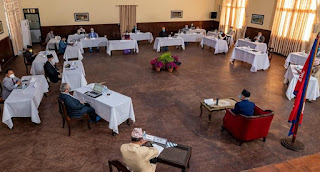Election Process (Civic Awareness)
Unit 5: Civic Awareness
Lesson 7: Election Process
Introduction
Election is a
legitimate process in which the voters choose their representative or participate
in the decision-making process using their voting rights. Similarly, people can
vote for any national issue which is called a referendum. The procedures
to be followed and performed during the election are known as the election process.
Importance of election
(Election of the spirit of democracy)
·
To run the country through the people’s representatives, To make the government more
responsible for people,
·
To ensure
people’s participation in the political decision-making process,
·
To legitimize
the government power,
·
To strengthen
the democratic system,
·
To handover the
power in a peaceful manner.
Bodies to conduct the election
(Following units are responsible to conduct the election
)
a.
Election Commission: According
to Article 245 of the constitution of Nepal, an Election commission is formed
of five Election Commissioners, the Chief Election Commissioner acts as the
chairperson. The Election Commission conducts, supervises, directs and controls
the elections for the President, Vice-president, Federal Parliament, State the legislature and local bodies.
b.
Election Officer: The Election Commission appoints the
Election Officers who conduct the election in different election
constituencies.
c.
Polling Officer: Polling Officers are appointed to
conduct the election in different polling centres and make necessary
arrangement of the booth, security management, make the election in scheduled time and
submit the ballot box to the concerned authority.
Electoral Roll: Electoral roll is an official list of the names
and addresses of people of a specific area who are entitled to vote in an
election. Election commission updates the electoral roll every year and
includes the name of people who attend 18 years of age to ascertain the voting
right of people as Nepali citizen,
Voter identity card: Voter identity card
is needed for casting vote in the election. It includes the name, address, identity
card number and photograph of the voter. It is useful to identify the real
voter using biological characteristics such as fingerprints or iris patterns
and prevent proxy votes.
Polling Station: Generally, public places like
school, playground, etc are chosen place for casting votes during the election which
are known as a polling station.
Ballot: The total number of votes that have
been cast in an election is called a ballot.
Ballot paper: It is a paper consisting of the
election symbols or names of candidates or political parties to stamp on it,
fold and drop into the ballot box.
Ballot Box: It is a box where the ballot paper is
dropped.
Election Code of Conduct: It is a set of rules
or guidelines issued by the Election Commission during the election. It should
be abided by candidates, political parties, government, public institutions,
employees, mass media, INGOs, observers, etc.
Electoral System
a.
First-Past-The-Post: Electoral System: The system of electing only one candidate who
gets more votes than any other candidate.
b.
Proportional Electoral System: The percentage of the popular vote won by the party is
converted into seats.
c.
Single Transferable Vote Electoral System: Surplus votes of candidate with high
priority shift to candidates with lesser priority in the same order the
electorates marked their preferences.
Manifesto: it is the main document that voter must read before casting vote
in the election. In manifesto particular political parties and candidate
themselves announce their manifesto and promised to citizens for further development
with the new plan. It includes the political ideology of a particular party that must
accept democratic norms.
Remarks: This note has been made to
help students in a particular subject. While making this; a student, SMIT RAI of Grade-X-2077 from CAMBRIDGE
is helping me a lot and it is on the base of the textbook.






I shall be more happy to receive feedback here::::
ReplyDelete